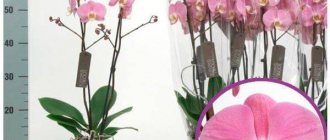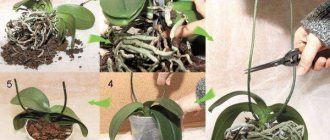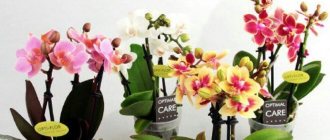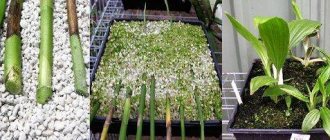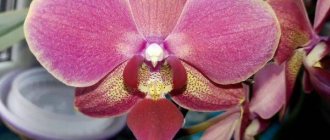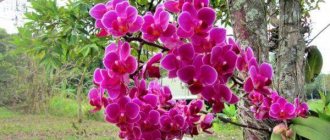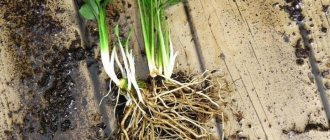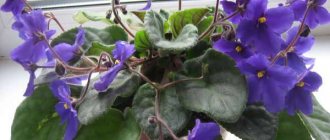In search of a means of earning money, many have beaten their feet. Maybe they didn't raise them. But the flower business is not disappearing.
Looking at flower sellers, I was always surprised by their persistence and resilience.
I see and know that many colors are not sold . I didn’t really delve into their office.
I have one argument in their favor. If they had flown by, they would not have traded. Then you notice that they do not disappear, but thrive. Along with the colors sold.
Just a few words about international business :
- This is about growing and selling orchids. And phalaenopsis, including. The USDA recorded $100 million in orchid sales . Three quarters of them are phalaenopsis. Some go to sell flower seedlings. Others for cutting. Business is booming;
- This is data from fifteen years ago. Add another zero at the back just in case. Not less. Over the years, not just development, but an orchid boom.
But even today, even those who like to grow them at home do not know the amazing history of their development;
- Research botanist Georg Rumpf in the seventeenth century was able to talk about these plants discovered during an expedition on the Moluccas. But even before that, almost three thousand years ago, they were a subject of fascination. And a welcome gift from noble ladies;
Orchids on the Moluccas. - And here is a new boom . It used to be with natural plants. And now with greater opportunities to create hybrids... There is immeasurable money here. Considering the demand. And he is unpredictable. And amazing. They know that the flower is artificially colored. But they shell out decent money for it;
- I will name only famous botanists - researchers of phalaenopsis: It was they who determined the name (phalaenopsis is like a butterfly);
- They also suggested when to spot them (at dusk with binoculars). Karl Liney, Karl Blume;
- But now scientists claim that there are more than 70 species of this plant.
Remember:
- You will not be able to find all the names of varieties in Russian;
- There are facts that the southern regions of China are the birthplace of phalaenopsis. And Japan claims this;
- They are classified as epiphytes ( growing on other plants). These are phorophytes. They don't harm each other. It’s hard to believe in our time;
- Both in the plains and in the mountains of Southeast Asia, Latin America, and Australia, they grow and bloom with might and main. No feeding.
to distinguish phalaenopsis:
- By the leaves. Only 5-6 elongated leaves (from 5 to 30 cm). Dark green. There are also marble designs;
- Peduncles (maybe 2-3) grow from the axils of the leaves;
- Many large flowers are born on them. They also look like butterflies (or moths);
- Aerial roots are very noticeable. From the same sinuses.
Replanting and fertilizing phalaenopsis
A healthy-looking plant is replanted every 2-3 years.
It is recommended to engage in this process after flowering has completed, preferably in the summer or late autumn. The main reasons for replanting are: the small volume of the pot or its damage; unpleasant odor from the substrate, its salinity; the appearance of pests.
The ideal type of pot is considered to be transparent. It is here that the process of photosynthesis of roots occurs best.
Before planting in the substrate, you need to carefully examine the roots, cut off dry and rotten particles, and make sure there are no pests.
Land for replanting can be purchased at any flower shop or prepared yourself. Tree bark, pieces of coal, sphagnum moss, and pieces of shells are suitable for these purposes.
The following soil composition for phalaenopsis also has a positive effect on the root system: pebbles (needed for drainage), charcoal, a small amount of dry pine bark.
To give the plant a blooming appearance, it is recommended to use phosphorus extracts or other “orchid” fertilizer purchased at a flower shop.
You can also spray the leaves with a slightly diluted solution, since beneficial substances also come through them.
Dilute the product strictly according to the instructions so as not to cause burns to the roots and leaves.
How to care for Japanese cherry trees?
During active growth and fruit formation, the tree needs additional watering. The soil should not be allowed to dry out; if there is insufficient precipitation, then it is worth additionally watering the plant.
In spring, fertilizers or compost are applied (6–8 kg per tree). Superphosphate, urea and potassium sulfate are added at the rate of 18 grams per square meter. With a lack of minerals, the cherry tree stops blooming and begins to shed its leaves.
Sakura reacts very sharply to a lack of micro- and macroelements.
The plant should be pruned in the spring. Trim dry, broken and unnecessary branches
It is very important to do this before the sap begins to flow (approximately the end of March - beginning of April). Need to cut with sharp garden shears
The cutting angle should be 45 or 65 degrees. The cut areas must be treated to prevent gum formation and protect against parasites.
At the beginning of spring, the tree is sprayed with nitrophen (200 g per 3 liters of water). This substance kills spores and prevents the spread of fungal diseases (for example, coccomycosis, which causes dark spots on the leaves). Sometimes a decoction of wormwood or nettle tincture is also used.
It is important to periodically carry out preventive maintenance and inspect the tree for the presence of parasites and diseases. Cherry is susceptible to parasites such as cherry slimy sawfly, aphids, cherry weevil, hawthorn, cherry moth
The presence of a disease and parasites may be indicated by the following symptoms: the appearance of plaque on the leaves, discoloration, yellowing or curling of leaves, curvature of the trunk or the appearance of cracks. At the first signs of infection, it is important to immediately begin treating sakura and prevent the disease from spreading.
It doesn’t hurt to put a special frame or net around the sakura that will protect the plant from small animals, such as moles or mice. If there are large mammals such as deer nearby, it is better to wrap the tree trunk with special polymer materials.
Young trees must be covered for the winter. Mature plants are more frost-resistant, but it doesn’t hurt to prepare them for winter. The sakura is covered with agrofibre, and the grafting and stem sites are tied.
The secret of the name
How many years does a phalaenopsis orchid live?
how to determine the age of this flower The genus Phalaenopsis belongs to the epiphytic plants of the Orchidaceae family. The plant is native to the plains and forests of Southeast Asia, the Philippines and northeastern Australia. The characteristic structure of plants belonging to this genus includes:
- Long vertical stem.
- Several large fleshy leaves arranged in two rows.
- Large velvety flowers, similar to exotic butterflies.
Thanks to these flowers, phalaenopsis got its name, since in translation from Greek phalania means “night butterfly” and opsis means “resemblance.”
In nature and special nurseries, there are about 70 species and a huge number of hybrid varieties of phalaenopsis orchids.
Features of transplantation
Spring Festival: sakura in the interior of a city apartment
It is better to replant the purchased plant immediately, replacing the soil with fresh one. You also need to carefully check the roots. In purchased containers they often entwine the entire substrate.
In this situation, they need to be carefully untangled. Remove rotten and wet ones. If the roots are completely healthy, the Cymbidium stardust can simply be transferred to a slightly larger pot. No clear container required. The best material is porous ceramics.
The main requirement for the substrate is lightness and ability to pass air. One type of mixture: pieces of coal, pebbles, pumice and pine bark with moss. The nutritional components will be peat fibers, dry leaves and some horn shavings.
Transplantation step by step:
Pour water-soaked substrate into the bottom of a container with drainage holes.
You need to take enough of it so that the orchid in the pot grows at the same level. Carefully remove the cymbidium from the old container and examine the roots as described above. Spread them on fresh soil without twisting them. Fill the empty space and compact the soil. This procedure is carried out every three years after flowering has completed.
The condition of the bulbs will serve as a signal for transplantation. If in the center they are brown and dried out, and at the edges there is a green mass and roots protruding from the pot, it’s time to change the container and substrate
This procedure is carried out every three years after flowering has completed. The condition of the bulbs will serve as a signal for transplantation. If in the center they are brown and dried out, and at the edges there is a green mass and roots protruding from the pot, it’s time to change the container and substrate.
For a week after transplanting, watering is reduced.
Often the owners of these exotic plants are interested: there are a lot of leafless bulbs on the cymbidium, what should I do? The leaves of the flower remain green for about three years. After which they gradually die off.
Only pseudobulbs remain, which remain alive for several more years. Gradually they will shrink and die.
Note! A living pseudobulb is capable of sprouting. Therefore, you should not throw them away; it is better to plant them and encourage the appearance of young plants.
Phalaenopsis Lewis Sakura: photo
Phalaenopsis Lewis Sakura is considered one of the most popular flowers. He personifies femininity. The plant does not require special care and adapts to negative environmental factors. The flower's hardiness allows it to be grown in any conditions.
Growing Phalaenopsis Lewis Sakura
Features of the variety
The variety was bred in Central Asia. It is called phalaenopsis sakura because it resembles the Japanese cherry tree. The main stem is straight. Its height is about 60 cm. The peduncle reaches a height of 30-45 cm.
The leaves of Phalaenopsis Lewis Sakura are large in size and reach 20 cm in length. Their color is rich green and does not change throughout the life of the flower. According to the description, the leaves form a leaf rosette during development. Shoots form from it and the root system develops. The roots are dense and thick. The lifespan of the plant is approximately 20 years.
The plant blooms 3 times during the year. Often this process lasts for 50-60 days. The orchid remains at rest for 90-100 days. With increasing age, the bush forms more shoots and flowers, and the duration of flowering increases.
Preparing for landing
Phalaenopsis Sakura Lewis cannot be planted in regular soil. Ordinary soil is not able to hold the orchid so that it remains in an upright position and poorly allows oxygen to pass through it. It is better to plant the crop in pine bark. Before planting, the soil must be disinfected. For this, use a manganese solution (4 g per 10 liters of water).
Phalaenopsis Sakura Lewis is a light-loving orchid. Even the root system needs a lot of light, so transparent containers are used for planting. Ordinary glass jars or transparent plastic food containers are often used as pots.
Planting stages
Planting a flower is not at all difficult
The plant should be in an upright position. To do this, planting is carried out according to certain rules.
- 200-300 g of substrate is poured into the prepared container;
- a seedling is placed there in a vertical position;
- The roots and the seedling itself are gradually sprinkled with soil so that the substrate forms the top layer.
After planting, the crop is watered with a small amount of water (1-1.5 liters per bush). The flower is placed in a dark place and after 3-4 weeks is transferred to well-lit areas.
Transfer rules
Transplantation is carried out 2 times a year: in spring or autumn.
It is prohibited to replant a flowering plant: there is a possibility of damaging the root system. Orchids are propagated using sprouts. Suitable for the procedure are shoots with a formed root system and no damage to the surface.
Home care
To grow a beautiful and healthy plant, it is important to properly care for it. The culture should receive a large amount of oxygen, but it should not be left in a draft. Daytime temperature should be 25°C, and night temperature should be 15-18°C
The daytime temperature should be 25°C, and the night temperature should be 15-18°C.
The Lewis Sakura orchid is watered in a non-standard way: an adult plant is dipped in warm water (about 20-23°C). Irrigation work is carried out no more than 2 times a month, kept in water for 25-40 minutes. After this, the pot with the flower is removed from the water and left for 40-60 minutes for the liquid to completely drain from the pot.
Feeding is carried out every 14-18 days. For this purpose, mineral components are used. An excellent option is to water with a solution of potassium nitrate (50 g per 10 l of water) or superphosphate (30 g per 10 l of water).
Diseases and pests
Main diseases: root rot and powdery mildew. It is impossible to get rid of root rot - the entire bush is destroyed. A measure of the fight against powdery mildew is Bordeaux mixture, with which watering is carried out (5 g per 10 liters of water).
The crop is protected from pests, so there is no need to worry about processing and protecting it.
Preventive measures
It is important to carry out timely prevention of diseases in an adult plant: spray the plant with a solution of copper sulfate (2 mg per 10 liters of water). The procedure is carried out at intervals of 7-10 days. Prevention of powdery mildew consists of treatment with phytosporin (20 mg per 10 liters of water)
Prevention of powdery mildew involves treatment with phytosporin (20 mg per 10 liters of water).
P.Liu's Sakura / Phalaenopsis Lewis Sakura / my care I received the phalaenopsis Liu's Sakura “KF” Phalaenopsis as a gift!:) Receiving an order from the orchid forum!
Conclusion
It is easy to grow the Phalaenopsis Sakura Lewis orchid at home. It is necessary to carry out agrotechnical procedures correctly. This variety is unpretentious in care, which only simplifies the process of growing it.
Bonsai
Experts consider sakura to be an ideal tree for bonsai - it grows slowly, so having bought a young plant, you don’t have to worry that in a year or two it will have to be replanted outside, especially since the vertical growth of the tree will be restrained by constant pruning of new shoots and pruning of roots.
https://youtube.com/watch?v=KfnDFHDsRjk
You can buy such a plant in special stores. A small cherry blossom tree looks the same as an older tree, only the diameter of its inflorescences does not exceed one centimeter (usually pink). When creating a bonsai, you must remember that the plant, although small, is alive, and not a stone, insensitive toy, and therefore, if it is not given enough attention or the wrong approach is taken, it may die.
The container for bonsai should be shallow and its diameter should be from 15 to 20 cm. Sakura bonsai prefers to grow on well-fertilized soil. It is advisable to add organic fertilizers to the soil a month before planting, nitrogen - simultaneously with planting, potassium and phosphorus, which promote the circulation of useful substances in the plant - in the summer. If the soil is poorly fertilized, the amount of humus should be from 8 to 12 g/dm3, and in a moderately fertilized soil it should be about five.
Japanese sakura loves good lighting, and therefore must be in a bright place (if it stands in the shade, there is a risk of powdery mildew). When looking for a place for a plant, you should take into account that it really does not like drafts.
Water the bonsai tree once a day (half a glass of water), less often in winter. The small plant is replanted annually, cutting off 1/3 of the rhizomes (branches can also be done, but don’t get carried away, since sakura doesn’t like that). If caterpillars, woodlice, red mites, bark beetles and aphids are found in the soil, you must immediately destroy them with insecticides, otherwise they will very quickly destroy the plant.
Types of phalaenopsis with photos
Pleasant (amabilis, Amabilis)
Up to twenty delicate white flowers bloom simultaneously on the graceful curved branches of this plant.
Amabilis.
The center is pale yellow with a pattern of pink, red and brown specks.
The edges of the lower petals are narrow and often curved upward, like teeth. The subtle, barely noticeable aroma gives it a special charm.
Schilleriana
The leaves of a plant that grows in suitable conditions have a subtle silvery pattern on the outside, as if marbled.
Schilleriana.
A whole waterfall of petals can bloom simultaneously on one peduncle - 250 flowers is not the limit, but an average number!
Shades of Phalaenopsis Schiller can range from pale pink to sophisticated burgundy.
Stuart (Stuartiana)
A profusely blooming species of Phalaenopsis Stewart, it features an attractive pattern on white flowers.
Stewart's Phalaenopsis has red spots on the base and a specific pattern.
A raceme of several dozen flowers develops on a peduncle up to 60 cm long.
The long, up to 20 cm leaves of the plant also have a pattern of silver-gray rounded spots.
Has a weak aroma.
Sandera (Sanderiana)
It is rare and expensive. The flower brush is located on several branches.
Sanderiana.
The total height of the peduncle is slightly less than a meter, about 80 cm. Large flowers, up to 10 cm in diameter, are white or pink.
The leaves have a dark green complex pattern.
Pink (Rosea)
A petite beauty with an intricate veining pattern on the large upper petals and a contrasting lip in a darker shade of purple.
Rosea. Photo taken from flickr from a certain Carl Baldini.
The name of this species accurately describes the coloring features. The diameter of the flower is only about 3 cm, and the peduncle is no higher than 20 cm. The leaves are a rich dark green color.
Gigantea
Flowers 3-4 cm in diameter are collected in a luxurious inflorescence in the form of a cone, drooping down.
Very large Phalaenopsis gigantea.
The leaves of this giant are often longer than the peduncle - up to fifty cm, and the peduncle usually does not exceed forty.
The flowers are variegated in shades: purple, beige, terracotta. The green mass is also often decorated with a pattern of light gray speckles.
Horse (Equestris)
Small flowers of this species are only 2-3 cm in diameter, but this only adds lightness and grace.
Equestris.
This baby's flower brush is only 20 cm in height, but it looks voluminous and lush.
Many small branches form an airy flower cluster.
At its tip, new buds grow and bloom, thanks to which it blooms all year round with good care.
Staghorn (cornu-cervi)
In comparison with its lush, bright neighbors, this phalaenopsis looks extremely unusual.
The coloring resembles the horns of a young deer.
With its shape, the staghorn phalaenopsis resembles not only the horns of a young deer, but also a starfish.
The shape is noticeably different, the petals look thicker and stronger.
The plant is miniature, but produces several flower stalks with many branches at once.
The inflorescences are varied in color from yellow ocher to reddish brown.
Luddeman
The petals look like they were painted by an artist. This species is extremely varied in colors.
Phalaenopsis Luddeman.
There are yellow flowers with red stripes, white with purple. A plant in full bloom can bloom regardless of the time of year.
Although there are very few flowers on the peduncle, no more than 7, they are quite large and smell pleasant. Average diameter 6 cm.
Ambonian (amboinensis)
This species of the orchid family blooms all year round, opening buds one after another. As a rule, there are several flower stalks at once.
Ambonian phalaenopsis.
Striped petals with bright, attractive colors stand out among the pink and purple palette of popular varieties.
Parisha (Parishii)
Among all the variety of these beautiful plants, there is not a single one that could be called ordinary.
Parishii.
Parisha is one of the more exotic varieties, a tiny potted plant with aerial roots and leaves that looks like a painstaking composition created by a florist.
Hybrids based on it are used to create mini-phalaenopsis.
Hieroglyphic (hieroglyphica)
The complex painting on the individual petals of this large plant is not repeated even on one peduncle.
Hieroglyphic.
Leaves up to 30 cm, many flowers on several peduncles look like a living bouquet.
Leaves and flower stalks tend to droop, so a stand is needed. A plant full of detail and personality.
Three-lobed almond varieties
The most common varieties grown in the middle zone are Plena and Kyiv.
Louiseania Plena is a rather spreading low bush with double pink flowers measuring 4 - 4.5 cm, having about 40 petals. Blooms in early May, after the leaves bloom, blooms for about 2 weeks.
Louiseania Kyiv is taller, the bush can reach a height of 3 - 3.5 m. The flowers are from pink to dark pink, about 3.5 cm in diameter, with 10-12 petals. They have a strong pleasant almond aroma. Flowering is abundant, before the leaves bloom, which makes Kievskaya more spectacular in comparison with the previous variety. Flowering duration is about 7 days.
CARE RECOMMENDATIONS
A heat-loving plant that needs shelter for the winter.
Prefers sunny places protected from the wind.
Grows well in light, fertile, well-drained soils.
Does not tolerate waterlogging and stagnation of moisture.
Reacts well to the application of organic and mineral fertilizers.
Lewis Sakura
Distinctive features, external characteristics
Phalaenopsis Lewis Sakura is considered one of the most feminine flowers. This is an unpretentious and hardy plant.
The stem of the crop is erect or slightly inclined. The growth of the flower can reach 60 cm, the peduncle – 40 cm.
Lush evergreen leaves 10–30 cm long are collected in a rosette from which shoots and thick aerial roots grow. The lifespan of a flower is 10 – 15 years.
Lewis Sakura variety.
Colors
Basically, the orchid has soft pink flowers along the edges, framed by a lilac border. The core of the inflorescences is yellow or orange.
There are flowers that are pale matte with a red throat, yellow with a purple tint, white with red specks in the middle, or completely purple.
Features and duration of flowering, dormant period
The flower blooms 2 times a year, for 2 months. The rest period is 3 months.
With age, the plant increases the number of shoots, peduncles and flowering period.
Find out in the video how to properly care for Lewis Sakura:
Phalaenopsis hybr 2009-2019
Moderator: Moderators
- Go to page:
Phalaenopsis hybr 2009-2019
Post by Katerina » 10 Feb 2009, 22:09
Some of the industrial hybrids
_______________________________________________________ Let's enjoy the abundance of colors. [ai.gif] [icon_flower.gif]
To be continued. I LOVE them very much [love10.gif]
Re: Phalaenopsis hybr.
Post by Olga V. » February 11, 2009, 12:43 pm
Re: Phalaenopsis hybr.
Post by Altapova Tatyana » 11 Feb 2009, 23:56
Sakura
The most favorite flowers of the Japanese
Sakura is a tree of the Plum subfamily of the Rosaceae family. The color of the flowers varies from snow-white to crimson and scarlet. Japanese law does not define the “state flower,” but sakura has become so firmly established in Japanese culture that it can be considered a symbol of Japan along with the chrysanthemum.
There are more than 600 varieties of cherry blossoms in Japan, including native and hybrid varieties. Somei-yoshino is the most common
with five-petaled pale pink flowers, developed in the mid-Edo period (1603-1868) and spread throughout the country from the Meiji period (1869-1912).
Sakura variety Somei-yoshino
The Japanese cherry tree occupies such an important place in Japanese culture that the word “flowers” in literature is often used as a synonym for the word “sakura”, dating back to the Heian period (794-1192). Spring picnics with relatives, colleagues, and acquaintances under the cherry blossoms are an integral attribute of spring in Japan.
In all regions of Japan there are places famous for the beauty of cherry blossoms, and even some individual cherry trees are famous throughout the country. Such, for example, is the very old “Sakura of the Age of the Gods” (Jindaizakura
) in Yamanashi Prefecture, which is about 2000 years old, or "Sakura Falls in Miharu" ( Miharu-takizakura
), which is more than 1000 years old, in Fukushima Prefecture.
Cherry blossoms are also closely connected with new meetings and partings, with turning points in human life. The financial and academic year in Japan begins on April 1, and this date falls during the time when cherry blossoms bloom in Kanto and more western regions (usually from the last ten days of March to mid-April). This is when school graduation events take place, this is the period of admission to school, to work, and those who successfully passed the entrance exams are said to have “sakura blossoms.”
Ueno Park in Tokyo while admiring the sakura
Sakura in Japanese cuisine
Sakura is not only admired. Wood, flowers, leaves, and sakura fruits are used on the farm. The fruits of some varieties are eaten. Soft flowers of oshimazakura
and Yaezakura
salted and then prepared from them into sweets or other dishes.
Pickled sakura flowers, if thrown into hot water, take on their previous shape, as if blooming again, and therefore have a benevolent meaning and a drink from them, sakurayu
, are a favorite treat during dates arranged for the purpose of marriage ( o-miai
), or at weddings. In addition, these flowers are used to decorate bread or cookies, and are also boiled with rice to add flavor.
Cherry blossom drink - sakurayu (left) Pink sakuramochi rice cake made from glutinous rice and botamochi made from a mixture of glutinous and regular rice (right)
Sakura in Japanese culture
Sakura was first mentioned in the chronicle-mythological collection “Annals of Japan” ( Nihon shoki
), completed in 720. It tells how a flower fell into a bowl of sake held by the 5th century Emperor Rityu. In later literature, there are many works in which sakura appears. They are not only about the beauty of flowers and hanami
, “admiring flowers” under flowering trees. The exquisite features of beautiful women are likened to sakura flowers, they express respect to sakura, which blooms for so short a time and then crumbles overnight, they see in it a courageous acceptance of one’s fate and cite it as an example of impermanence, the frailty of existence. Thus, sakura became a symbol of the fleeting beauty of the transient, having a certain influence on the formation of ideas about life and death.
The Japanese love for sakura survived the post-war reforms and now manifests itself in music. One of the most famous songs, a kind of “calling card” of Japan, is called “Sakura, Sakura”, and in general the number of songs with this word in the title has exceeded a hundred; songs whose lyrics mention sakura are impossible to count.
Popular types
Phalaenopsis Cleopatra. It is distinguished by the yellow color of the flower with small burgundy spots. The lip of this species is lilac. There may be several flower stalks. The flowers are small. Approximately 5-7 centimeters. Phalaenopsis Cleopatra, like other hybrid varieties, is unpretentious in care.
Phalaenopsis bellina. The stem is greatly shortened, the leaves are green, shiny and rounded. They reach 20-30 centimeters in length. On peduncles that can survive several seasons, 3-5 flowers develop. Their petals are elliptical. Color – white-green combined with purple. During the day, the scent of the flowers is very strong. The aroma is floral.
Phalaenopsis Zambia. This species blooms profusely. Flowering colors are lilac-blue. The older the plant, the more peduncles and flowers it produces. The height of the orchid is approximately 40 centimeters. Has a pleasant floral aroma.
Phalaenopsis Philippine. Found only in the Philippines. An epiphytic species that attaches to trees. It is noteworthy that this flower feels good at an altitude of more than 1000 meters above sea level. Leaves are usually up to 25 centimeters in length. Their width does not exceed 10 centimeters. The color is silver-green.
Phalaenopsis Nemo. This is a flower with unusual colors. There is a purple mesh perpendicular pattern on a creamy pink background. It has thick aerial roots and a short stem. The leaves are shiny and collected in rosettes of 3-5 leaves. Peduncles grow several times a year. Usually twice. Flower height up to 70 centimeters.
Phalaenopsis wild peach. It is distinguished by its orange color with brick specks. The lower part of the flower is yellow.
In addition to the listed Phalaenopsis varieties, the following are also distinguished:
- Phalaenopsis equina. It differs in the color of the peduncle. She is violet-purple. The flowers are light pink.
- Phalaenopsis Harlequin. So named because of the bright color of the buds. White, pink and crimson colors shimmer harmoniously on a bud that has not yet blossomed.
- Phalaenopsis Kimono. The burgundy color of the petals is in harmony with its unusual structure.
- Phalaenopsis Hummingbird. Known for its compactness and strikingly beautiful flowers.
Photo gallery of different varieties of Phalaenopsis.
In this article, we discussed the types and varieties of Phalaenopsis orchid.
Features of correct landing
Regardless of varieties and varieties, all phalaenopsis require the same conditions for planting and propagation.
How to choose soil
Orchids do not accept ordinary soil. This is due to the fact that it cannot simultaneously hold the plant in an upright position and at the same time allow air to pass through.
The best soil for phalaenopsis orchids is pine bark.
Therefore, natural soil with bark and moss substrates is required for planting.
Important! Before planting, the soil and substrate must be disinfected. To do this, the soil is treated with potassium permanganate at the rate of 5 g
products per 10 liters of water, and the substrate is boiled for 30 minutes.
Capacity
Phalaenopsis are light-loving plants, in which even the root system needs lighting.
For this reason, flowers are grown in a transparent container. You can use glass jars or a plastic container for the pot.
Technology
In order for the plant to have a vertical appearance, it is planted as follows:
- Large pieces of substrate are poured into the prepared pot;
- Then the seedling is installed and leveled;
- The plant is alternately covered with soil and drainage so that the top layer ends with the substrate.
After planting, it is recommended to water the seedling and move it to a dark place. After several weeks, the plant is moved to a well-lit area.
Conditions of detention
If you decide to buy Sakura Lewis, you must provide her with the necessary comfort:
- heat: in summer within 22-25°C, in winter - from 18° to 20°C;
- humid air around the pot (at least 60%) using a humidifier or an open flat vessel with water;
- day from 10 to 12 hours without direct sunlight on the leaves. In winter - turn on the phytolamp;
- protection from drafts;
- permanent place without changes.
The roots of phalaenopsis are involved in photosynthesis, so pots for such plants should be transparent. Drainage holes are necessary to remove excess moisture from the roots.
The size of the container for orchids is selected taking into account the free location of the root system in the substrate, but so that part of them touches the walls.
For a variety with a heavy flower cluster, a pot with a wide, stable base is more suitable.
